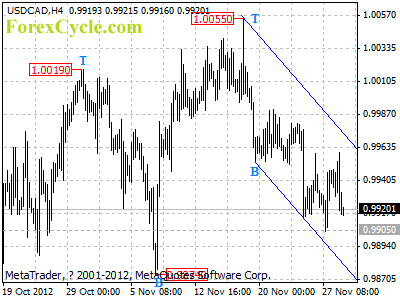Source: ForexYard
The price of crude oil and gold tumbled yesterday, as concerns about the upcoming US “fiscal cliff”, a series of automatic tax increases and spending cuts set to take place if the US Congress fails to reach a budget deal, led to risk aversion in the marketplace. The safe-haven Japanese yen and US dollar both gained as a result of investor fears. Today, in addition to any “fiscal cliff” developments, the US Prelim GDP, Unemployment Claims and Pending Home Sales figures are all forecasted to generate market volatility during afternoon trading.
Economic News
USD – Dollar Advances Due to Investor Risk Aversion
While the USD/JPY turned bearish for most of the day yesterday, the greenback was able to post significant gains against its higher-yielding rivals due to fears regarding the upcoming US “fiscal cliff”. Against the Canadian dollar, the USD gained more than 20 pips during European trading, eventually trading as high as 0.9956. The USD/CHF advanced more than 30 pips before peaking at 0.9339. A slight downward correction brought the pair own to 0.9325 by the evening session.
Today, dollar traders will want to continue monitoring any developments in the budget negotiations between US Congressional leaders. In addition, the US Prelim GDP and Unemployment Claims figures, both set to be released at 13:30 GMT, followed by the Pending Home Sales at 15:00, all have the potential to generate market volatility. If any of the indicators come in above expectations, risk taking could result in the safe-haven greenback giving up some of yesterday’s losses.
EUR – Global Economic Fears Sends Euro Tumbling
The euro took heavy losses against both the safe-haven US dollar and Japanese yen yesterday, as uncertainties regarding a recent Greek bailout agreement combined with a possible upcoming US fiscal crisis sent led to risk aversion among investors. The EUR/USD fell more than 60 pips during the European session, eventually trading as low as 1.2879. Against the JPY, the common-currency gave up more than 40 pips during mid-day trading to reach 105.30, a one-week low.
Today, analysts are warning that the euro could take additional losses if the ongoing budget negotiations in the US remain deadlocked and investors continue shifting their funds to safe-haven assets. Additionally, traders will want to pay attention to the results of an Italian 10-year bond auction. If the bond auction shows that Italian borrowing costs have gone up, the euro could extend its bearish trend during mid-day trading.
Gold – “Fiscal Cliff” Fears Cause Gold to Slump
The price of gold fell by more than $30 yesterday, to reach a three-week low at $1705.85 an ounce, as fears regarding the US “fiscal cliff” and its potential to send the US back into recession caused investors to shift their funds to safe-haven assets. By the end of European trading, the precious metal saw a slight upward correction and was trading at the $1713 level.
Today, gold traders will want to pay attention to a batch of US data along with any developments in Congressional budget negotiations. Unless positive news is released, analysts are warning that gold prices could continue falling throughout the day.
Crude Oil – Oil Receives Minor Boost Following US Inventories Report
After falling by close to $1.50 a barrel to reach as low as $85.70 during European trading yesterday, the price of oil was able to stage a slight upward recovery following a lower than expected US Crude Oil inventories figure. US stockpiles fell by 300,000 barrels last week in a sign that demand has gone up. As a result, crude was able to bounce back to the $86.40 level during afternoon trading.
Today, oil traders will want to pay attention to the US Prelim GDP, Unemployment Claims and Pending Home Sales figures. Should any of the news come in above analyst expectations, speculations that demand for oil will go up may drive the price of oil higher.
Technical News
EUR/USD
While the MACD/OsMA on the weekly chart appears close to forming a bearish cross, most other long-term technical indicators show this pair range trading. Taking a wait-and-see approach may be the preferred strategy here until a clearer picture presents itself.
GBP/USD
The Bollinger Bands on the weekly chart are beginning to narrow, indicating that this pair could see a price shift in the coming days. Additionally, a bearish cross is close to forming on the same chart’s MACD/OsMA. Traders may want to open short positions for this pair.
USD/JPY
The Williams Percent Range on the weekly chart has crossed over into overbought territory, indicating that this pair could see a downward correction in the coming days. In another sign of impending bearish movement, the Relative Strength Index on the daily chart appears close to crossing above the 70 level. Going short may be the wise choice for this pair.
USD/CHF
While the daily chart’s Bollinger Bands are beginning to narrow, indicating that a price shift could occur in the near future, other long-term technical indicators are failing to provide clear signs about what direction the shift will be. Taking a wait-and-see approach may be the best option for this pair.
The Wild Card
NZD/USD
The Bollinger Bands on the daily chart are narrowing, indicating that a price shift could occur in the near future. Additionally, the Slow Stochastic on the same chart has formed a bearish cross, indicating that the price shift could be downward. Forex traders may want to open short positions ahead of possible downward movement.
Forex Market Analysis provided by ForexYard.
© 2006 by FxYard Ltd
Disclaimer: Trading Foreign Exchange carries a high level of risk and may not be suitable for all investors. There is a possibility that you could sustain a loss of all of your investment and therefore you should not invest money that you cannot afford to lose. You should be aware of all the risks associated with Foreign Exchange trading.





